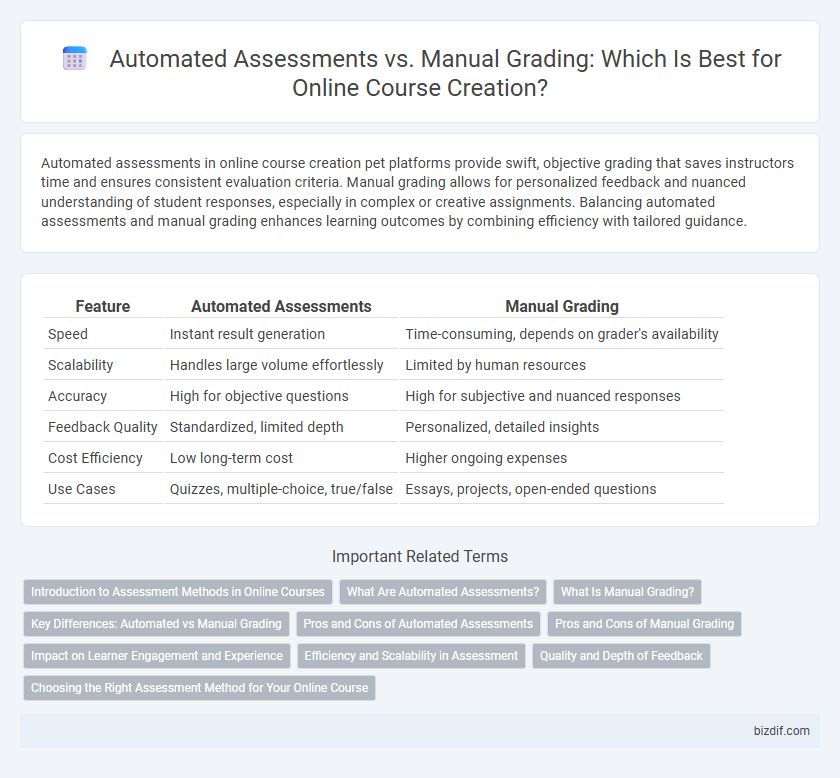Automated assessments in online course creation pet platforms provide swift, objective grading that saves instructors time and ensures consistent evaluation criteria. Manual grading allows for personalized feedback and nuanced understanding of student responses, especially in complex or creative assignments. Balancing automated assessments and manual grading enhances learning outcomes by combining efficiency with tailored guidance.
Table of Comparison
| Feature | Automated Assessments | Manual Grading |
|---|---|---|
| Speed | Instant result generation | Time-consuming, depends on grader's availability |
| Scalability | Handles large volume effortlessly | Limited by human resources |
| Accuracy | High for objective questions | High for subjective and nuanced responses |
| Feedback Quality | Standardized, limited depth | Personalized, detailed insights |
| Cost Efficiency | Low long-term cost | Higher ongoing expenses |
| Use Cases | Quizzes, multiple-choice, true/false | Essays, projects, open-ended questions |
Introduction to Assessment Methods in Online Courses
Automated assessments in online courses utilize algorithms and AI to provide instant feedback and scoring, enhancing efficiency and scalability for large student groups. Manual grading, performed by instructors, offers nuanced evaluation and personalized feedback crucial for complex assignments and subjective criteria. Combining both methods in online course design optimizes accuracy, learner engagement, and overall assessment quality.
What Are Automated Assessments?
Automated assessments utilize algorithms and AI technology to evaluate student performance quickly and consistently, providing instant feedback on quizzes, assignments, and exams. These systems analyze responses based on predefined criteria, enabling scalable grading for large online courses without human intervention. Automated assessments enhance efficiency and accuracy, reducing instructor workload while maintaining objective evaluation standards.
What Is Manual Grading?
Manual grading involves instructors evaluating student assignments and exams by hand, allowing for personalized feedback and nuanced understanding of each response. This method enables educators to assess creativity, critical thinking, and subjective answers that automated systems may overlook. Despite being time-consuming, manual grading ensures tailored evaluation and can adapt to complex or open-ended questions in online course creation.
Key Differences: Automated vs Manual Grading
Automated assessments provide immediate, consistent grading by using algorithms to evaluate objective questions, reducing instructor workload and enabling scalable course delivery. Manual grading allows for nuanced evaluation of subjective answers like essays, fostering personalized feedback but requiring significant time investment from educators. The key difference lies in automated grading's efficiency and standardization versus manual grading's depth and adaptability in assessing complex student responses.
Pros and Cons of Automated Assessments
Automated assessments offer rapid grading and immediate feedback, enhancing learner engagement and scalability for online courses. However, they may lack the nuanced understanding of complex responses and critical thinking skills, potentially reducing accuracy in subjective evaluations. Balancing automation with selective manual grading can optimize efficiency while maintaining assessment quality in digital learning environments.
Pros and Cons of Manual Grading
Manual grading in online course creation offers personalized feedback tailored to individual student responses, enhancing learning outcomes through nuanced evaluation of complex assignments. However, it is time-consuming and may introduce subjective bias, affecting consistency and scalability in large classes. Despite these challenges, manual grading remains essential for assessing creativity, critical thinking, and open-ended tasks that automated assessments often fail to evaluate accurately.
Impact on Learner Engagement and Experience
Automated assessments provide immediate feedback, enhancing learner engagement by allowing quick corrections and continuous improvement. Manual grading offers personalized insights and nuanced evaluations, fostering deeper learner reflection and motivation. Balancing both methods can optimize the learning experience through timely responses and meaningful feedback.
Efficiency and Scalability in Assessment
Automated assessments significantly enhance efficiency by instantly evaluating large volumes of student submissions, reducing the time and cost associated with manual grading. Scalability is improved as automated systems can handle thousands of assessments simultaneously without compromising consistency or accuracy. Manual grading, while beneficial for personalized feedback, becomes impractical for large-scale online courses due to time constraints and variability in evaluator judgment.
Quality and Depth of Feedback
Automated assessments provide immediate, consistent grading but often lack nuanced feedback essential for deeper learning and personalized improvement. Manual grading enables instructors to deliver detailed, qualitative insights that address specific student misunderstandings and promote critical thinking development. Balancing automated efficiency with manual depth enhances the overall quality and effectiveness of online course evaluations.
Choosing the Right Assessment Method for Your Online Course
Automated assessments offer scalability and immediate feedback, ideal for large online courses requiring consistent grading. Manual grading provides nuanced evaluation, essential for subjective assignments like essays or creative projects. Selecting the right assessment method depends on course objectives, content type, and desired learner engagement.
Automated assessments vs Manual grading Infographic

 bizdif.com
bizdif.com